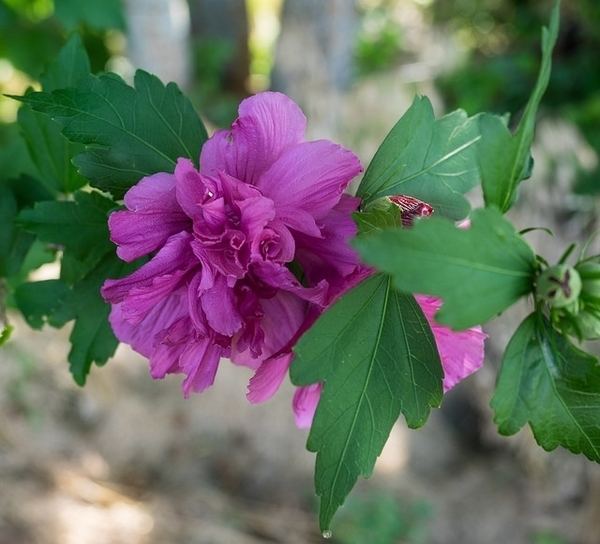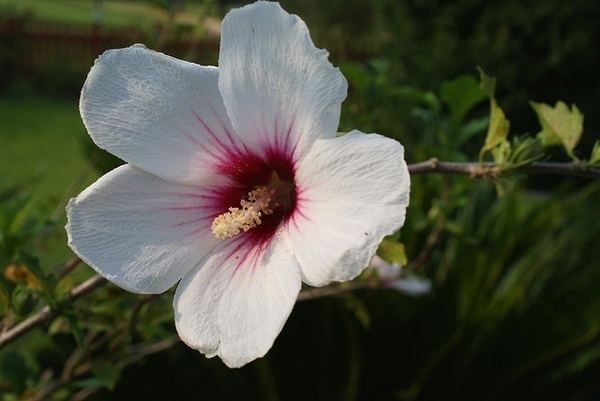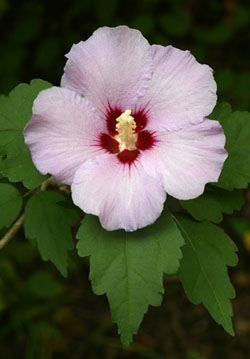Rank Species | Genus Hibiscus Higher classification Hibiscus | |
 | ||
Similar Hibiscus, Shoeblackplant, Mallows, Hibiscus mutabilis, Privet | ||
Hibiscus syriacus blue bird blue bird rose of sharon
Hibiscus syriacus is a species of flowering plant in the family Malvaceae, native to much of Asia (though not, as Linnaeus thought, Syria, in spite of the name he gave it). Common names include rose of Sharon (especially in North America), Syrian ketmia or rose mallow (United Kingdom) and St Joseph's rod (Italy).
Contents
- Hibiscus syriacus blue bird blue bird rose of sharon
- How to prune rose of sharon hibiscus syriacus
- Description
- Garden history
- Cultivars
- Propagation
- National flower
- References

How to prune rose of sharon hibiscus syriacus
Description

Hibiscus syriacus is a hardy deciduous shrub. It is upright and vase-shaped, reaching 2–4 m (7–13 ft) in height, bearing large trumpet-shaped flowers with prominent yellow-tipped white stamens. The flowers are often pink in color, but can also be dark pink (almost purple), light pink or white. Individual flowers are short-lived, lasting only a day. However, numerous buds are produced on the shrub's new growth, and this provides prolific flowering over a long summer blooming period. Shoots make interesting indoor vase cuttings, as they stay green for a long time, and some new flowers may open from the more mature buds. The species has naturalized very well in many suburban areas, and might even be termed slightly invasive, so frequently does it seed around.
Garden history

Hibiscus syriacus has been a garden shrub in Korea since time immemorial; its leaves were brewed into an herbal tea and its flowers are eaten. It was grown in Europe from the 16th century, though as late as 1629 John Parkinson thought it was tender and took great precautions with it, thinking it "would not suffer to be uncovered in the Winter time, or yet abroad in the Garden, but kept in a large pot or tubbe in the house or in a warme cellar, if you would have them to thrive." (sic) By the end of the 17th century, some knew it to be hardy: Gibson, describing Lord Arlington's London house noted six large earthen pots coddling the "tree hollyhock", as he called it, "that grows well enough in the ground". By the 18th century the shrub was common in English gardens and in the American colonies, known as Althea frutex and "Syrian ketmia".
Cultivars

Though it has no fall color and can be stiff and ungainly if badly pruned, H. syriacus remains a popular ornamental shrub today, with many cultivars. William Robinson mentioned several varieties in The English Flower Garden that are still available today. Triploid varieties were first produced at the National Arboretum, Washington DC, by Dr. D. Egolf, resulting in plants that bloom lavishly, as they are sterile and set no seed; Egolf varieties named for goddesses include the outstanding white 'Diana'. Also in the market are 'Lady Stanley', 'Ardens', 'Lucy', and 'Blushing Bride'.

Cultivars of H. syriacus are widely planted in areas with hot summers for their very attractive white, pink, red, lavender, or purple large and edible flowers. The following cultivars have gained the Royal Horticultural Society's Award of Garden Merit:-
Propagation
Hibiscus syriacus is fairly easily propagated from either seeds, with variable results, or by layering or cuttings, cloning the original.
National flower
Hibiscus syriacus, also known as the Korean Rose, is the national flower of South Korea. The flower appears in national emblems, and Korea is compared poetically to the flower in the South Korean national anthem. The flower's name in Korean is mugunghwa (Hangul: 무궁화; Hanja: 無窮花). The flower's symbolic significance stems from the Korean word mugung, which means "eternity" or "inexhaustible abundance". Various emblems of South Korea contain hibiscus syriacus.
